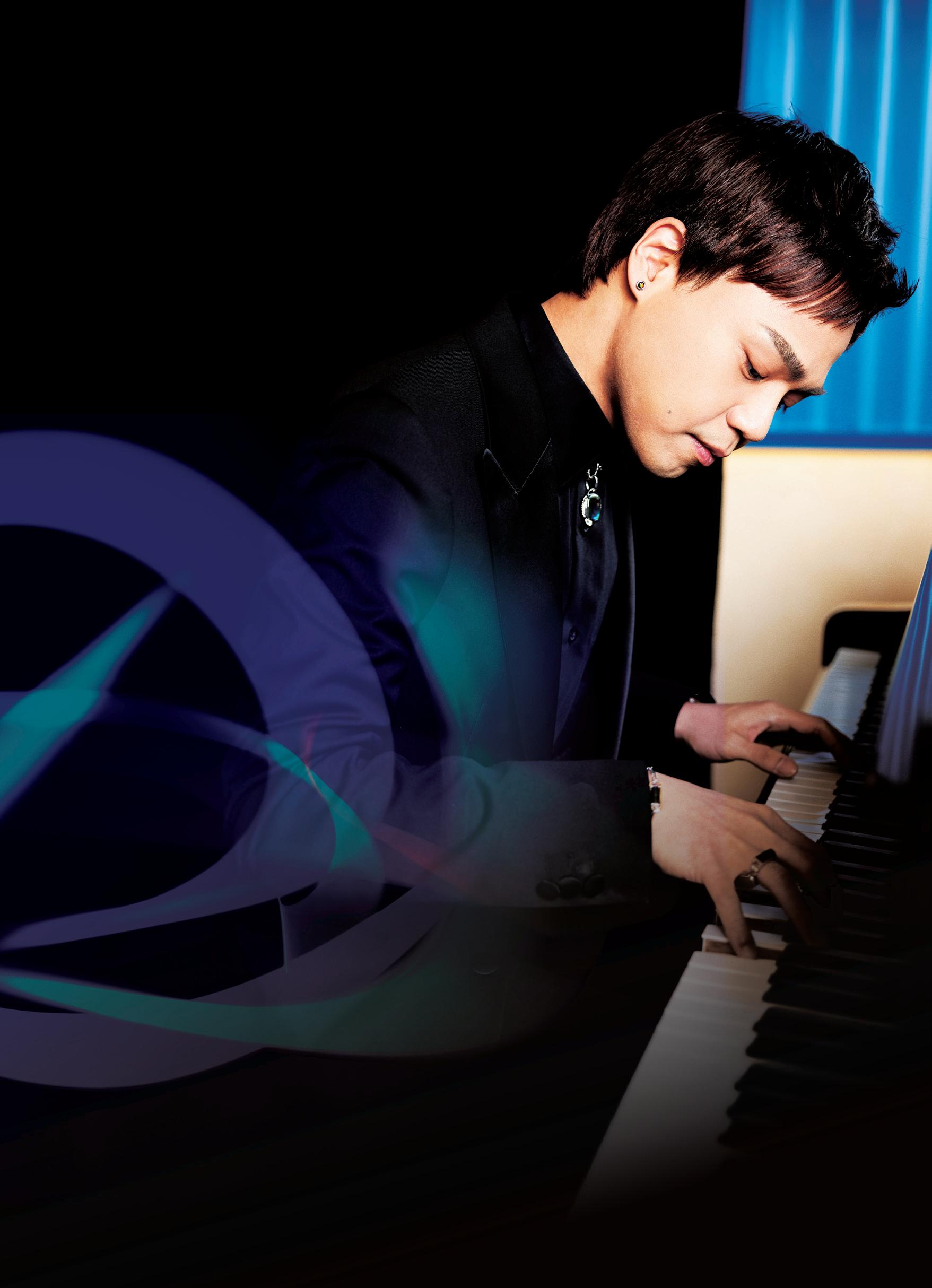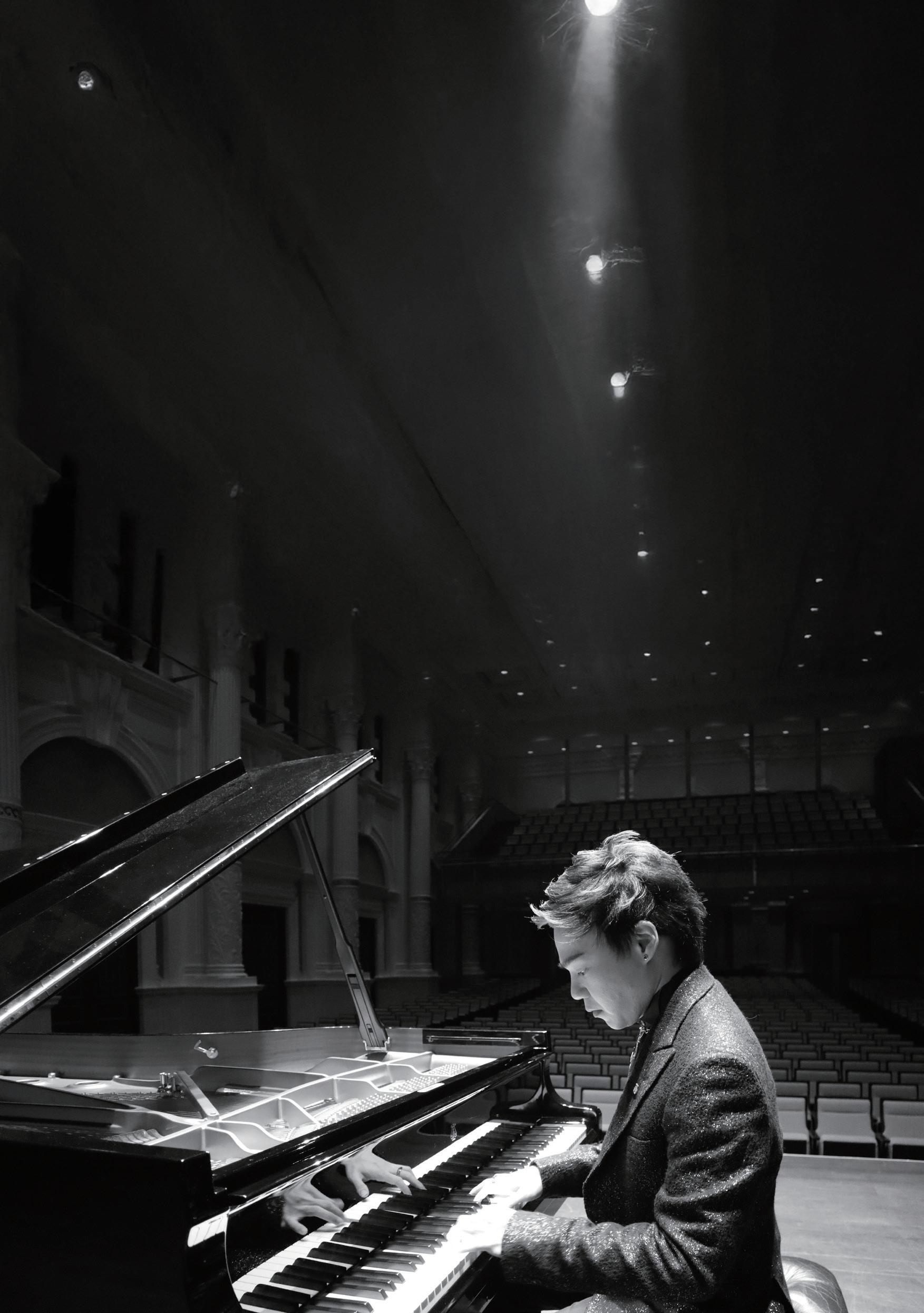THREE FANTASIES
CARL VINE (b. 1954)
1. Gothic Fantasy
2. Cerulean Fantasy
3. Fantasia Divina
The idea for this set of fantasies began with the commission of Gothic Fantasy for pianist Janice Carrisa, as her prize as Gilmore Young Artist at the 2022 Gilmore International Piano Festival in Michigan, USA. Her only request was that the music be "a fantasy" and I gave it the gothic qualifier to move towards the darker sides of the fantastical.
Fantasia Divina was commissioned by the Department of Music and Cultural Management Office of the University of Hong Kong with support from the UOB (United Overseas Bank) to be premiered at the University by my friend, Poom Prommachart, who asked if it could be a divine fantasy.
In English, divine can have the mundane meaning of delightful, and for me the Italian version, Fantasia Divina, suggests something more supernatural and superhuman, and hints at a mystical aspect to the incredible skill of a fine pianist. This work focuses on producing multiple waves of sound that it is hard to imagine emerging from a single instrument, or from just one musician. In the world of the divine , one must remember that deities not only inspire awe, but can also be implacable and unforgiving.
The centre of the triptych, Cerulean Fantasy , was composed as a gift to Poom so he could give the world premiere of the complete set at the University of Hong Kong today. The most striking aspect of my childhood summer holidays spent in the Darling Ranges outside Perth, Western Australia, was the endless blue skies stretching to the horizon. That impossibly deep blue still signifies to me warmth, relaxation, and the simplicity of youth.
Carl Vine, July 2025
Carl Vine AO is one of Australia's best known and often performed composers, with an impressive orchestral catalogue featuring eight symphonies and thirteen concertos. His piano music is performed frequently around the world and recordings of his music on more than 75 albums play regularly on international streaming platforms. He has composed an extensive range of chamber music alongside various work for film, television, dance, and theatre. Although primarily a composer of modern art music, he has undertaken such diverse tasks as arranging the Australian National Anthem and writing music for the Closing Ceremony of the Olympic Games (Atlanta, 1996).
Born in Perth, he studied piano with Stephen Dornan and composition with John Exton at the University of Western Australia. Moving to Sydney in 1975, he worked as a freelance pianist and composer with a wide range of ensembles, theatre, and dance companies over the following decades.
Amongst his most acclaimed scores are Piano Sonata (1990) and Poppy (1978) for the Sydney Dance Company, and Choral Symphony No. 6 (1996) for the West Australian Symphony Orchestra. His first six symphonies are available on the ABC Classics album Carl Vine: The Complete Symphonies performed by the Sydney Symphony Orchestra. Much of his chamber music is available on three albums on the Tall Poppies label (TP013, TP120, and TP190).
From 2000 until 2019, Carl was Artistic Director of Musica Viva Australia, the world's largest chamber music entrepreneur. Within that role he was also Artistic Director of the Huntington Estate Music Festival from 2006, and of the Musica Viva Festival (Sydney) from 2008. Carl has been Senior Lecturer in Composition at the Sydney Conservatorium of Music since 2014. His recent compositions include Five Intermezzi for solo piano, Piano Sonata No. 4, The Enchanted Loom (Symphony No. 8) for the Melbourne Symphony Orchestra, and Five Hallucinations, a trombone concerto for the Chicago and Sydney Symphony Orchestras. In 2014, Carl was appointed an Officer of The Order of Australia (AO) in the Queen's Birthday Honours List.
CLELAND BOYD McAFEE (1866–1944) /
arr. CAELEB TEE (b. 1991)
Near to the Heart of God
Near to the Heart of God is a hymn composed in 1903 by Cleland McAfee, a theologian and Presbyterian preacher, following the heartbreaking loss of his two infant nieces to diphtheria while he served at the First Presbyterian Church of Chicago. McAfee, deeply committed to the scholarly study of the King James Bible and the Christian faith, crafted a hymn with three verses that reflect themes of seeking quiet rest, release from sin, and divine comfort. The refrain expresses a profound yearning for spiritual closeness and solace in God's presence.
This arrangement, crafted in 2021 by Malaysian conductor and composer Caeleb Tee, honours McAfee's original intent while serving as a poignant tribute to loved ones lost, specifically dedicated to Pastor Lim Seng Heng and Tie Ai Hung, who succumbed to COVID-19. Set in D-flat major, the arrangement begins with the refrain, introducing the verse melody in the lower register before gracefully ascending to the higher register. This musical ascent evokes a sense of rising to an ethereal, spiritual space, resonating with the hymn's title and its message of divine connection.
FRÉDÉRIC CHOPIN (1810–1849)
Nocturne in E major, Op. 62, No. 2
Nocturnes are musical compositions inspired by the atmosphere and emotions of the night. Carl Czerny described them as "an imitation of those vocal pieces which are termed Serenades" in his School of Practical Composition , Op. 600, highlighting their lyrical quality. The melody of a nocturne often resembles the flowing, expressive cantilena style of Italian opera, typically supported by a broken-chord accompaniment.
Chopin's nocturnes, as noted by David Branson and Nicholas Temperley, were inspired by John Field, who pioneered the genre in the 1810s by utilising the piano's sustaining pedal to create novel, evocative sounds. Liszt, in the preface to the first collected edition of Field's nocturnes, credited Field with originating pieces that convey deep subjectivity and profound emotion. Chopin, building on this foundation, published his first set of nocturnes in 1832. His works expanded the form, introducing greater emotional depth,
varied piano figurations, and innovative phrase structures compared to the more restrained expressions of earlier nocturnes.
Chopin composed Nocturne in E Major, Op. 62, No. 2 in 1846 and dedicated it to Mademoiselle R. de Könneritz. This piece, the last nocturne published during his lifetime, showcases his mature style. It features contrapuntal complexity and an "endless melody" (unendliche Melodie). The nocturne follows a ternary form with a coda. Its main theme flows with subtle variations over gentle, arpeggiated chords. The middle section shifts to an agitated mood with triplet rhythms and a mix of dissonance and consonance in a contrapuntal texture. The piece ends with a shorter, calmer reprise of the opening theme.
FRANZ SCHUBERT (1797–1828) / FRANZ LISZT (1811–1886)
Gretchen am Spinnrade, D. 118
Erlkönig, D. 328
Franz Liszt, a pioneer in the realm of piano transcription, championed the principle of remaining faithful to the original work while permitting subtle artistic enhancements. In an 1880 letter to Count Géza Zichy, he wrote, "In transcription there is no need for too much invention: a certain conjugal fidelity to the original is usually best". With decades of experience, Liszt balanced preserving a piece's essence with its adaptation for piano. His transcriptions, fewer over time, showcased his virtuosic keyboard skill and ability to reimagine vocal works.
Liszt's experience in accompanying prominent singers likely informed his approach to transcribing lieder. In 1838, he arranged twelve of Schubert's lieder, published as Transkriptionen von Gesängen und Liedern . These inventive yet respectful transcriptions catered to both professional musicians and an expanding audience for art songs, exerting considerable influence on the musical landscape. Music critic Eduard Hanslick noted, "Liszt's transcriptions of Schubert's lieder were epoch-making. There was scarcely a concert in which Liszt did not play one or two of them; even when they were not listed on the programme they would have to be played as encores. Far be it from me to praise the artistic value of these transcriptions or even to see a glorification of Schubert in them. When one takes away the words and voice from Schubert Lieder, one has not glorified them, but rather impoverished them. Still the fact remains Wilhelm August Rieder, Franz
Schubert incontestable that Liszt, through these paraphrases, did a great deal for the dissemination of Schubert Lieder. Printed concert programmes prove that since the appearance of Liszt's transcriptions of Schubert songs, the originals have been publicly sung more frequently than before: the power of virtuosity proves itself once again and this time served a good cause". In 1860, some of these pieces were adapted for voice and orchestra, further expanding their reach.
Schubert's Gretchen am Spinnrade (1814), based on a poem from Goethe's Faust , depicts Gretchen at her spinning wheel, hopelessly preoccupied with thoughts of her beloved, Faust. The piano accompaniment mimics the relentless whir of the wheel, halting momentarily as Gretchen recalls her lover's words, touch, and kiss, creating a moment of rapture. The music swells to a passionate outburst as the spinning resumes before sinking back into melancholy. Liszt preserves these dramatic contrasts, heightening the intensity by thickening the texture and doubling the melody in octaves during the climactic moments. He performed his version at a charity concert in Vienna, demonstrating the transcription's capacity for emotional depth and expressive nuance.
Schubert's Erlkönig , also based on a Goethe text, presents a dark and breathless narrative propelled by the piano's urgent, galloping motif. The song unfolds as a harrowing journey involving four distinct voices—the narrator, the anxious father, the terrified child, and the menacing Erlking— each differentiated by vocal register. The father rides home with his son, who is tormented by the Erlking's tempting visions, ultimately leading to the child's death. Liszt's transcription, one of his earliest of Schubert's lieder, retains the rapid octaves that conjure the horse's frantic gallop and the foreboding bass motif. By varying melodic registers, Liszt highlights the distinct voices of the characters. Among his three versions of Erlkönig, Liszt's later revisions feature streamlined inner parts, lending clarity and amplifying the drama. This virtuosic transcription captivated audiences with its gripping storytelling and pianistic brilliance.
Carl Vine (b.1954)
Three Fantasies (World Premiere)
Programme notes on P.4
FRÉDÉRIC CHOPIN (1810–1849)
Ballades No. 1–4
After leaving behind his established career as a pianist-composer in Warsaw and an unproductive nine-month stay in Vienna, Chopin arrived in Paris in 1831. This move followed the failure of the November Uprising and the Russo-Polish War of 1831, events that had a profound impact on him personally and professionally. In Paris, Chopin began to explore new artistic directions, and the years from 1836 to 1842—when he composed and published his four Ballades—marked the most productive period of his career.
The genre that Chopin adopted and transformed, the ballade, had its origins almost exclusively in vocal music until the 1840s. In the Romantic era, composers such as Loewe and Schubert frequently set narrative poetry ballads to music, often using 6/8 or 6/4 meters, rhythms that also surface in Chopin's ballades. The title "Ballade" also appeared in French operas to describe simple narrative songs, further linking the genre to vocal and narrative traditions.
Chopin's Ballade No. 1 was dedicated to Baron Nathaniel von Stockhausen, the Hanoverian ambassador to France. Early advertisements even described the piece as "ohne Worte" (without words), highlighting its connection to the art song and emphasising its narrative, song-like qualities. Though this early Ballade draws from the Austro-German sonata tradition, Chopin favoured relationships of thirds over traditional dominant harmonies, an innovation that marked his approach to musical form.
Ballade No. 2 followed in 1839, composed during Chopin's stay in Majorca with George Sand while he was in poor health. Chopin dedicated this Ballade to Robert Schumann, reciprocating Schumann's earlier dedication of Kreisleriana, Op. 16, to him. Ballade No. 2 departs from conventional forms, presenting two strongly contrasted themes: a gentle, pastoral siciliano in F major and a turbulent section in A minor. Their interplay marked an innovative structural departure for the time. Chopin himself, writing to Julius Fontana, reflected some indecision over the dedication, oscillating between Schumann and his publisher.
Two years later, Chopin completed his Ballade No. 3, dedicating it to his pupil Pauline de Noailles. By this time, Chopin's compositional style had
grown increasingly meticulous, as reflected in his remark, "I cannot give them enough polish". This perfectionism slowed his output but resulted in works of exceptional refinement. Unlike the dramatic contrasts of the Second Ballade, the Third Ballade is notable for its thematic transformation and overall tonal stability, though it continues to incorporate stylistic elements like the waltz and siciliano found throughout the set.
Ballade No. 4, completed in 1842, was dedicated to Baroness Charlotte de Rothschild, who had introduced Chopin to the Parisian aristocracy. Additionally, some of his most important personal connections during this period were with Prince Alexander Czartoryski and Princess Marcelline. Ballade No. 4 is particularly distinguished by the integration of its introductory material with the main theme, the return of its introduction before the reprise, and the sophisticated use of countermelodies and nocturne-like ornamentation. Its structure blends a variety of formal devices, making it the most complex ballade of the set.
Throughout his Ballades, Chopin eschewed explicit programmatic content in favour of expressing inner emotional realities. Rather than narrating a specific story, the music invites listeners to interpret it as a kind of literary narrative, offering both unity and dramatic progression. This approach set Chopin apart from many of his contemporaries and moved beyond the classical tradition of multi-movement sonatas and chamber works, as well as post-classical concert forms like variation sets and rondos. Significantly, each of the ballades is structurally "end-weighted", culminating in a crescendo of formal complexity and emotional intensity.
Programme notes by
Rosanne Lee
BA in Music, The University of Hong Kong
MM in Vocal Performance, Johns Hopkins University
DMA in Performance, Voice, University of Michigan
Graduate Certificate in Musicology, University of Michigan
Supported by Presented by
















